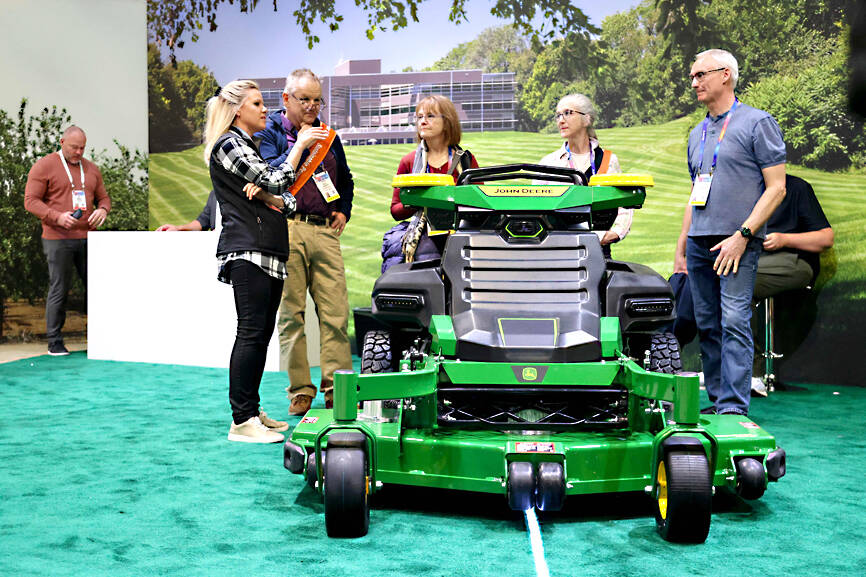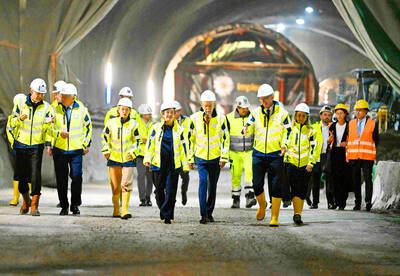Today’s robots perform safety checks at industrial plants, conduct quality control in manufacturing and are even starting to keep hospital patients company.
However, soon — perhaps very soon — these increasingly humanlike machines would handle more sophisticated tasks, freeing up people while raising complex questions about the roles of artificial intelligence (AI) that are gaining attention.
At a panel hosted by the American Association of Retired Persons (AARP) at this week’s Consumer Electronics Show (CES), experts described the next five years as a period in which robots transition primarily from industrial sites to service settings, helping to address a worsening healthcare labor crunch.

Photo: AFP
Seeing robotics in places like theme parks or universities “will lead to the companion robot probably at the end of the decade,” Boston Dynamics chief strategy officer Marc Theermann said.
Cris Gardner, a vice president in future casting at AARP, predicted robots would provide emotional support as they enter homes and assist with daily tasks.
People “will own a generalized humanoid robot the way they would own a car,” she said.
Dystopian prophesies of a robot-centered future have long featured in the public imagination. However, recent breakthroughs in generative AI have given more credibility to predictions of billions of humanoid robots in everyday life.
The centrality of robots in the coming years is “widely underappreciated,” said a report from Abundance 360, a conference and education venture led by entrepreneur Peter Diamandis.
Robots could enable an “era of unprecedented abundance,” lowering costs while freeing humans “to focus on creative and fulfilling pursuits,” it said.
However, the analysis also identified nine sectors facing potential job displacement, including manufacturing, eldercare, agriculture, education and surgery.
“The speed at which multimodal generative AI and humanoid robot development is progressing, paired with the lack of public discourse on this subject, indicates that there will be significant job disruption and societal upheaval,” it said.
Disputes over automation have been a recurring factor in labor negotiations, most recently involving US dockworkers, who reached a tentative agreement with a shippers’ group, averting a strike.
The International Longshoremen’s Association permitted ports to add semi-autonomous cranes only if more workers are hired, the Wall Street Journal reported.
At CES, companies described robots as performing tasks that humans either should not do because they are dangerous, or do not want to do because they are grueling, tedious or unpleasant.
Hong Kong company R2C2 showcased industrial robots that can perform functions such as inspections at power plants and technician work on trains, according to the company’s founder and chief executive San Wong.
Working on trains involves “lots of grease everywhere, and it’s dirty and hot” so turnover is high, Wong said.
Vehicle and equipment maker Oshkosh has used automation to phase out high-burnout jobs such as the finishing work on firetrucks, which requires workers to wear a mask and often leads to shoulder and elbow problems, chief executive John Pfeifer said.
Those workers have been shifted to other assembly line work, such as welding.
While these jobs are currently safe, they might “one day” be automated, Pfeifer said.
“This has been the evolution of the economy for 250 years,” he said. “People move into more productive ways to help the economy grow.”
At CES, US agriculture machinery giant John Deere showcased autonomous vehicles developed partly in response to persistent farm labor shortages.
Automation allows farmers to focus on more challenging tasks, such as managing grain movement from a field to a storage area, said Deanna Kovar, president of Deere’s worldwide agriculture and turf division.
“We need to continue to make sure we’re evolving the skill sets of our employees, of our customers, so that they can take advantage of the technologies and not see them as a threat,” she said.
The aging US population points to a significant labor gap for caring for the next generation of elderly people, Gardner said.
“The demand is going to be enormous, it can’t be covered by human beings,” said Gardner, who views improved robotics as key to enabling older people to stay independent for longer.

CHIP RACE: Three years of overbroad export controls drove foreign competitors to pursue their own AI chips, and ‘cost US taxpayers billions of dollars,’ Nvidia said China has figured out the US strategy for allowing it to buy Nvidia Corp’s H200s and is rejecting the artificial intelligence (AI) chip in favor of domestically developed semiconductors, White House AI adviser David Sacks said, citing news reports. US President Donald Trump on Monday said that he would allow shipments of Nvidia’s H200 chips to China, part of an administration effort backed by Sacks to challenge Chinese tech champions such as Huawei Technologies Co (華為) by bringing US competition to their home market. On Friday, Sacks signaled that he was uncertain about whether that approach would work. “They’re rejecting our chips,” Sacks

NATIONAL SECURITY: Intel’s testing of ACM tools despite US government control ‘highlights egregious gaps in US technology protection policies,’ a former official said Chipmaker Intel Corp has tested chipmaking tools this year from a toolmaker with deep roots in China and two overseas units that were targeted by US sanctions, according to two sources with direct knowledge of the matter. Intel, which fended off calls for its CEO’s resignation from US President Donald Trump in August over his alleged ties to China, got the tools from ACM Research Inc, a Fremont, California-based producer of chipmaking equipment. Two of ACM’s units, based in Shanghai and South Korea, were among a number of firms barred last year from receiving US technology over claims they have

It is challenging to build infrastructure in much of Europe. Constrained budgets and polarized politics tend to undermine long-term projects, forcing officials to react to emergencies rather than plan for the future. Not in Austria. Today, the country is to officially open its Koralmbahn tunnel, the 5.9 billion euro (US$6.9 billion) centerpiece of a groundbreaking new railway that will eventually run from Poland’s Baltic coast to the Adriatic Sea, transforming travel within Austria and positioning the Alpine nation at the forefront of logistics in Europe. “It is Austria’s biggest socio-economic experiment in over a century,” said Eric Kirschner, an economist at Graz-based Joanneum

OPTION: Uber said it could provide higher pay for batch trips, if incentives for batching is not removed entirely, as the latter would force it to pass on the costs to consumers Uber Technologies Inc yesterday warned that proposed restrictions on batching orders and minimum wages could prompt a NT$20 delivery fee increase in Taiwan, as lower efficiency would drive up costs. Uber CEO Dara Khosrowshahi made the remarks yesterday during his visit to Taiwan. He is on a multileg trip to the region, which includes stops in South Korea and Japan. His visit coincided the release last month of the Ministry of Labor’s draft bill on the delivery sector, which aims to safeguard delivery workers’ rights and improve their welfare. The ministry set the minimum pay for local food delivery drivers at